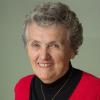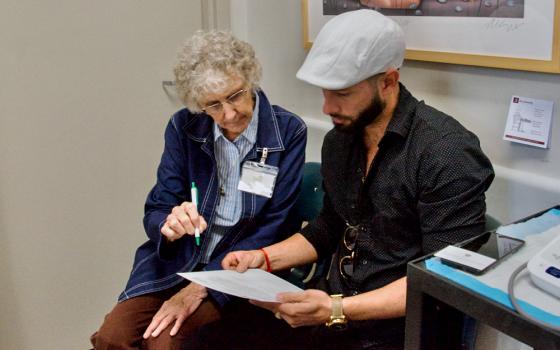It happened in the midst of LCWR's pending visitation from Rome on the viability and depth of commitment in orders of women religious in the United States.
One of Rome's great concerns about U.S. religious orders of women, it seems, is the lack of young early adult vocations in the United States today. Why U.S. women's orders, in the face of large-scale decline in numbers of both religious and priests in Europe as well, should merit such special attention on this subject, I'm not sure. I do think, however, that the subject in general needs to be rethought and perhaps reframed. Even by religious orders themselves.
So exactly where are the young? It can't be that they are not generous with their lives. There is simply too much data to the contrary to take that position. It can't be that women religious are not a significant spiritual presence in the world. The data for that lie in all the people from all stratus of society who are being touched by them. So, I wonder, what's really going on here?
Then one day, I got a glimpse of the answer head-on and in living color:
I was going through the lobby of one of the local hospitals and spotted a nurse who had just done some routine X-rays of me. We caught one another's eye at about the same time. I smiled, and she crossed the hall in my direction, a middle-aged woman with a quick step and a hearty presence.
It was one of those basic Catholic conversations:
"It's so well-organized here," I said.
"You bet," she said. "We were all trained by the sisters!" And we both laughed a tribute to nuns who brooked no dirt, no disorder, no mediocre work. The stories are legion.
"I went to a Catholic grade school," she went on. "Then to a Catholic high school, then to a Mercy college and to a Joseph nursing school," she finished, meaning, of course, to institutions built and administered by the Sisters of Mercy and the Sisters of St. Joseph.
"After all of that," I quipped, "you might as well have stayed. You had more than enough time in to claim you'd already had your novitiate."
Suddenly, the tenor of her remarks turned serious. "Well," she said, "don't be so sure I won't. After all," she went on even more thoughtfully, "it's not over yet."
I thought about that conversation for days. While the Vatican pronounces women's religious life dead because there are no 18-year-olds around anymore, we may all be missing the obvious: There are no 18-year-olds around anywhere anymore.
A continuing demand for more and more certification, education and experience has delayed adolescence in the West. People get married later now, too -- in their mid-20s to early 30s at least, and many even older.
They go from first grade to master's degrees in one fell swoop, or they go to school between jobs, or they do both a job and education together -- and slowly. Then they take a few starter jobs while they decide what they want to be when they grow up. And then they face the mound of college debts it will take most of them years to repay.
In a world that is living longer, learning longer, working longer, participating for years longer in a culture full of healthy elders, people are living life at a far more thoughtful, more productive pace than generations before us ever dreamed of, let alone planned for. There is time, always time, they're sure, for everything.
So what are we to think about it all? The church calls it secularism and materialism. Maybe. But there are other explanations, as well. Like longevity. Or maturation. Or even a better sense of the fullness of life.
It occurs to me that at a time like this, we might all profit from the model given by other cultures and other religions. It might bring light to our own situation to consider the findings of other eras and the approaches of other, more wisdom-centered peoples.
Many Buddhists, for instance, still accept children into the monastery. But they don't expect most of them to stay forever. They take them into monastic life simply to prepare them spiritually to recognize and pursue a spiritual dimension of life throughout their lives -- wherever they are, whatever they finally do.
Sufi orders, followers of the mystical dimension of Islam, just assume sufis will take spiritual development seriously. At the same time, many of them relate to their sufi orders while living a family life and professional life. The sufi way, they say, is "outwardly with the people, inwardly with God." Their focus while in the marketplace of life is to continually remember God.
Hindus, most of all, perhaps, take into account the "ages" of development. Hinduism, in fact, has long taught that there are four stages of life.
The first stage, the Hindus teach, is the age of childhood, however long it takes to acquire the maturity necessary to begin to function beyond the control of the family.
The second stage is the age of the student. During this preparatory period, students concentrate for years on learning the skill or profession that will enable them to function independently in society in order to give back to the larger world -- for the sake of its own development -- what they have been trained to do.
The third stage of life, the Hindus tell us, is the age of the householder, the keeper of a family, whose concentration on others develops the next generation to carry on the values and ideals of this one.
Finally, Hinduism teaches, a person reaches the age of the sanyasi, the truth-seekers, who give themselves over in this last stage of life to the pursuit of spiritual development. These people -- educated, experienced, responsible -- take these final years to bring perspective to their own lives and wisdom to others. It's the period of reflection. For some, it is the period of monastic reflection. The period when, relieved of the burden of social responsibility, they become the standard-bearers of the soul.
Maybe we ourselves are finally getting there, too. Maybe the age of religious life is turning upside-down in a culture where other responsibilities come earlier and stay longer. No, women are not coming to religious life now to be trained in adulthood. They are coming to religious life as adults to be trained in wisdom and faith, in spiritual development and public ministry.
From where I stand, the current change in the age of vocations to women's religious life is neither a sign of loss nor deficiency. In fact, we may be getting a little wisdom ourselves.



